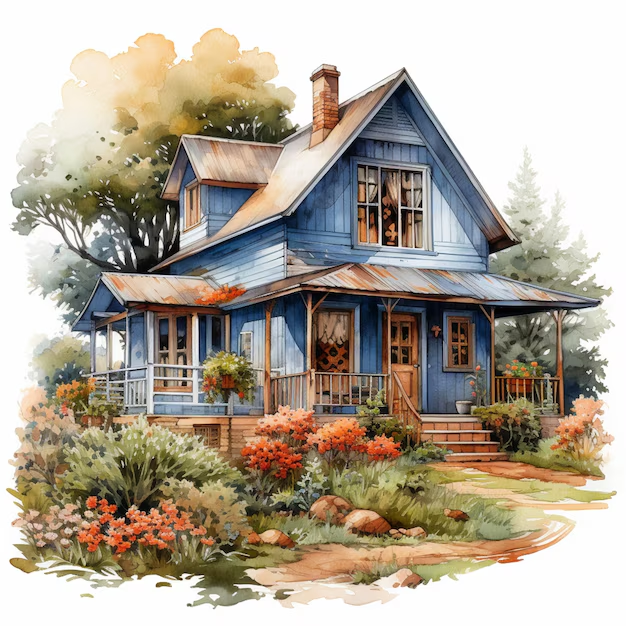Exploring the Art of House Drawing: Techniques, Trends, and Benefits

Mia spent countless afternoons sketching her dream house with a pencil and paper as a child. She imagined wide porches, large bay windows, and a cosy attic. Over time, her sketches became more detailed, and her fascination with house drawings grew. Now, as an adult, Mia finds herself drawn to the same pastime—only this time, with a sketchbook and a set of professional markers. What started as a simple childhood activity has become a cherished hobby, allowing Mia to unwind and bring her architectural fantasies to life.
House drawing, for many like Mia, is more than just a hobby; it’s a creative escape, a way to explore personal design preferences and a skill that blends art with architecture. Whether you’re an aspiring architect, a seasoned artist, or someone who enjoys doodling in their free time, house drawing offers a unique way to engage with imagination and precision.
The Growing Popularity of House Drawing
Drawing houses has become increasingly popular, especially with the rise of digital platforms that make learning and sharing art easier than ever. Platforms like YouTube and Skillshare offer tutorials ranging from basic sketching techniques to advanced architectural drawing. According to YouTube Analytics, videos related to house drawing and architectural sketching have seen a 30% increase in views over the past three years, reflecting a growing interest in this creative field (Source: YouTube Analytics, 2023).
The appeal of house drawing lies in its accessibility. Unlike other forms of art that may require specialized materials, house drawings can begin with just a pencil and paper. Whether a simple sketch of a cosy cabin or a detailed blueprint of a modern mansion, house drawing allows artists to create without extensive resources, making it an ideal activity for beginners and professionals alike.
Why People Draw Houses: The Appeal of Architectural Art
Drawing houses combine art, design, and architecture, allowing people to explore their creativity while thinking about structure and space. Here are some reasons why house drawing has captured the interest of so many:
- Creative Expression and Personalization
For many, house drawing is a way to express personal style and preferences. Just as some people design dream homes on paper, others find satisfaction in sketching real-life buildings, capturing the unique details that give them character. According to a survey by Artfinder, 67% of people who draw regularly do so because it gives them a sense of personal satisfaction and a way to express themselves (Source: Artfinder, 2022).
House drawing is also highly customizable. Artists can explore architectural styles, from minimalist modern designs to intricate Victorian structures. This flexibility makes it an appealing art form for those who enjoy experimenting with different aesthetics.
- Enhancing Observation and Attention to Detail
Architectural drawing, particularly house drawing, requires a keen eye for detail. Artists must consider proportions, angles, and perspectives, sharpening their observational skills. A 2019 study published in the Journal of Applied Art Education found that students who engaged in architectural drawing showed a 25% improvement in spatial awareness and attention to detail over a semester (Source: Journal of Applied Art Education, 2019).
This focus on detail improves drawing skills and enhances general observation, helping artists notice the subtleties in their surroundings, whether the way light hits a building or the texture of brickwork.
- Stress Relief and Mental Health Benefits
Like many creative activities, drawing has been shown to have significant mental health benefits. An American Art Therapy Association study found that 75% of participants reported feeling less stressed after engaging in a drawing activity, even for just 45 minutes (Source: American Art Therapy Association, 2021). For those who choose house drawing as a hobby, sketching and designing can be a therapeutic way to unwind and disconnect from daily stresses.
Moreover, the repetitive motions involved in drawing—such as shading, outlining, and detailing—can provide a meditative experience, allowing the mind to relax and focus on the present moment.
Learning to Draw Houses: Techniques and Tools
While anyone can start drawing houses with a simple pencil and paper, specific techniques and tools can elevate a drawing from a basic sketch to a detailed architectural illustration.
- Perspective Drawing
Understanding perspective is essential in house drawing, as it gives depth and realism to the artwork. Most architectural drawings use either a one-point or two-point perspective. One-point perspective is ideal for simple, frontal views, while two-point perspective is used for more dynamic angles, such as corner views of a building.
Numerous online tutorials teach perspective drawing. Websites like Skillshare and Udemy offer courses that cover the basics of perspective, helping beginners understand how to make their house drawings more realistic.
- Choosing the Right Materials
While house drawing can begin with basic materials, upgrading to professional tools can enhance the drawing experience. Common materials for architectural sketching include:
- Graphite Pencils: These are ideal for initial sketches and shading. Many artists recommend using a range of pencils (e.g., HB, 2B, 4B) to achieve different levels of darkness.
- Fine-Liner Pens: These are essential for outlining and adding details. Pens with varying tip sizes (0.1mm to 0.5mm) allow artists to create bold outlines and fine details.
- Markers or Watercolors: Adding colour can bring a drawing to life. Markers are great for modern, clean styles, while watercolours add a softer, more textured feel.
- Digital Tools for House Drawing
With the advancement of digital technology, many artists now use digital tools for architectural drawing. Software like Procreate and Adobe Illustrator provides a range of brushes, layers, and perspective grids, making creating detailed and polished house drawings easier. According to Adobe’s 2022 Digital Art Report, digital drawing applications have seen a 45% increase in users over the past five years as more artists transition from traditional to digital mediums (Source: Adobe, 2022).
The Role of House Drawing in Architecture and Design
House drawing is not only a popular hobby; it also plays a crucial role in architecture. Many architects begin their design process with simple sketches, which evolve into detailed blueprints and digital models. According to the American Institute of Architects (AIA), 85% of architects start with hand-drawn sketches before moving to digital platforms, underscoring the continued relevance of drawing in architectural practice (Source: AIA, 2021).
Mastering house drawing is an essential skill for architecture students. Many architecture programs require students to take courses in freehand drawing to help them develop an understanding of spatial relationships, proportion, and perspective.
House Drawing as a Social Media Trend
House drawings have also become popular on social media platforms like Instagram and Pinterest, where artists share their work and inspire others. Hashtags like #housedrawing and #architecturalillustration have thousands of posts, showcasing everything from simple line drawings to elaborate, coloured illustrations.
According to Instagram’s internal data, posts related to architectural drawings and house illustrations have seen a 50% increase in engagement since 2020, as more people turn to social media for inspiration and tutorials (Source: Instagram, 2023).
Conclusion
House drawing offers a unique blend of creativity, structure, and personal expression. Whether sketching a cosy cottage or a grand mansion, the process allows you to explore architectural styles, improve your observational skills, and enjoy a meditative, stress-relieving activity. With the wealth of online resources, anyone can begin their journey into house drawing, regardless of skill level.
For those like Mia, who rediscovered her childhood passion for house drawing, the hobby provides a creative outlet connecting imagination with design. As house drawing continues to grow in popularity, both as a pastime and a professional skill, it offers a valuable way for people to engage with architecture—one pencil stroke at a time.








